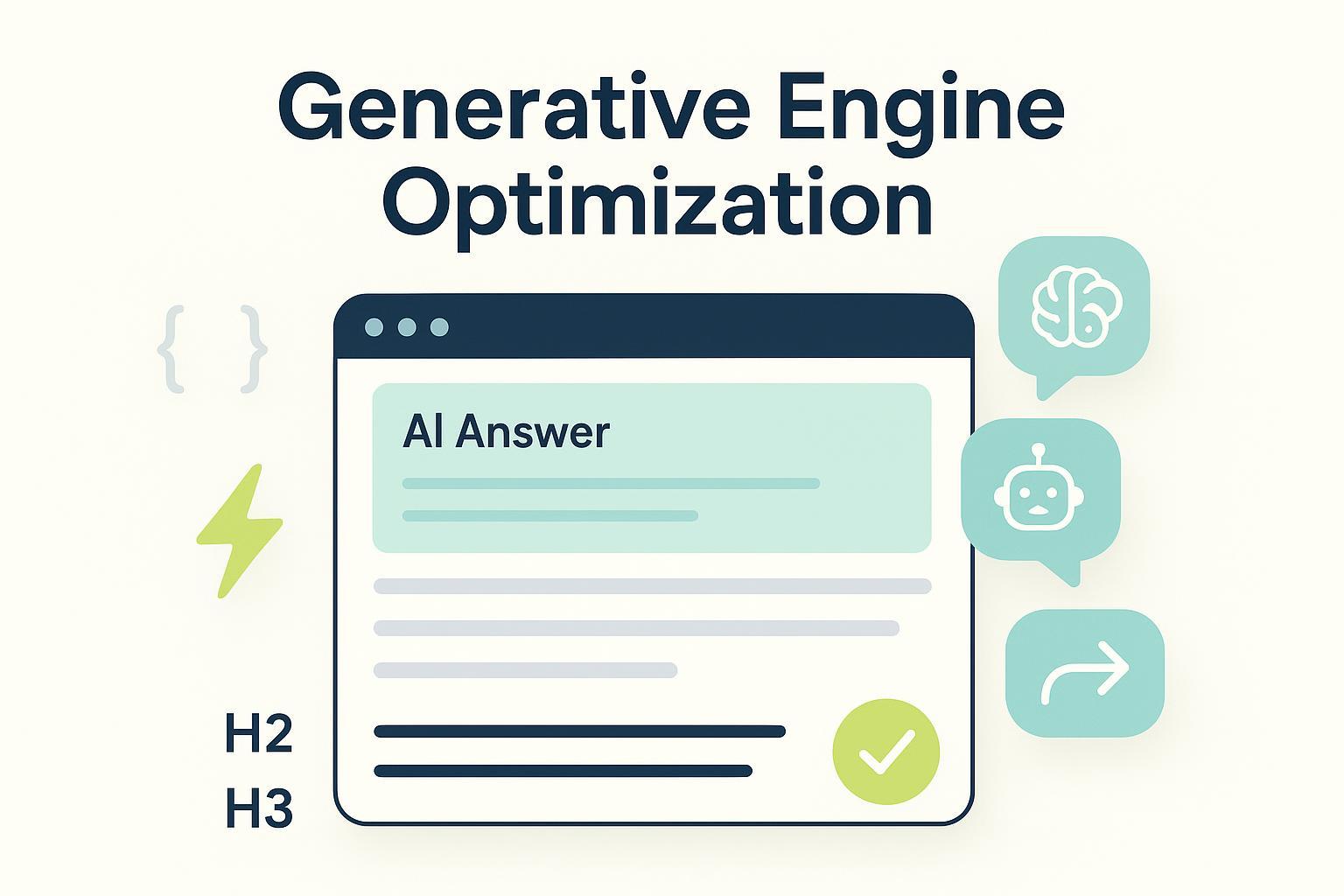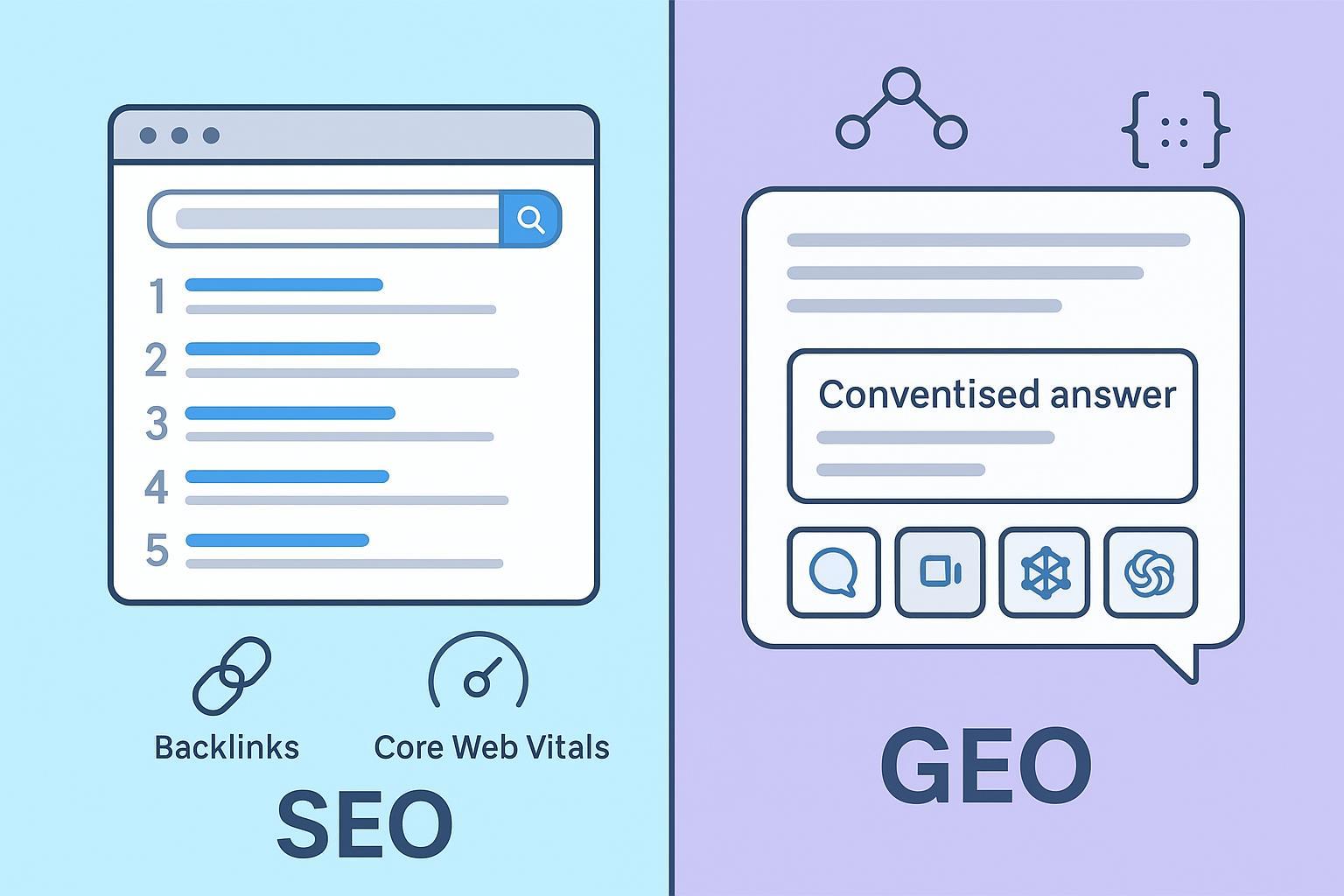GEO vs. AEO (Answer Engine Optimization): Key Differences
Compare GEO and AEO to understand how Answer Engine Optimization focuses on direct answers, while GEO integrates content into AI-generated responses.


In today's world of AI search, two methods stand out: GEO and AEO. GEO, or Generative Engine Optimization, helps your content show up in AI search results. It works by matching with AI-created answers. AEO, or Answer Engine Optimization, focuses on making clear answers. These answers appear directly in search results, like featured snippets or voice searches.
AI is changing digital marketing faster than ever before. By 2025, AI will run 80% of marketing plans. Voice search already makes up half of all online searches. Over 71% of people use voice search. Knowing about GEO and AEO is key to staying ahead in this fast-changing world.
Key Takeaways
GEO (Generative Engine Optimization) helps your content show up in AI answers. This is important for businesses wanting to be seen in AI searches.
AEO (Answer Engine Optimization) gives clear, simple answers. This is key for showing up in voice searches and featured snippets.
Using organized data and easy-to-read formats helps AI tools and search engines pick your content.
Mixing GEO and AEO strategies can help your content reach more people and work better in AI searches.
Watching performance metrics for both GEO and AEO shows how your content is doing and where to make it better.
What is GEO (Generative Engine Optimization)?
Definition and Purpose of GEO
GEO, or Generative Engine Optimization, helps your content show up in AI searches. It’s different from regular SEO, which focuses on search engine rankings. GEO makes sure your content fits with AI-generated answers. This helps tools like ChatGPT or Google AI use your content in their replies. The goal of GEO is to improve visibility in AI-powered searches.
Using GEO makes your content easier for AI systems to understand. You need to organize your content so AI can process it well. GEO is important for businesses that want to stay ahead in the AI-driven world.
How GEO Works: Mechanisms and Strategies
GEO works by making your content better for AI algorithms. It focuses on creating clear, detailed content that AI can use in its answers. Here are some strategies:
AI-Friendly Content Structure: Use headings, lists, and short paragraphs to help AI read your content.
Keyword Optimization: Add keywords naturally to match AI questions.
Schema Markup: Include structured data to help AI understand your website better.
AI Tools: Tools like Geneo give tips to improve your GEO strategy.
These steps make your content useful and easy for AI systems to find.
Applications of GEO in AI-Driven Search
GEO has many uses in AI-based searches. It helps businesses show up in AI answers, making their content easier to find. For example, companies can use GEO to improve supply chain content for AI tools. A study shows how a North American company used GEO to boost supply chain efficiency:
Company Type | Strategy Used | Early Impact | Long-term Result |
|---|---|---|---|
North American | Supply chain changes/localization | Stronger and better supply chain |
This shows how GEO can bring lasting benefits by matching content to AI needs. Whether for voice search, chatbots, or AI assistants, GEO keeps your content useful and visible.
What is AEO (Answer Engine Optimization)?
Definition and Purpose of AEO
AEO, or Answer Engine Optimization, helps your content give direct answers. Unlike regular SEO, which improves rankings, AEO focuses on clear answers. This makes your content show up in voice searches or snippets.
The goal of AEO is to make your content easy to find. When your answers match what people ask, search engines show them first. This is why AEO is important for businesses in today’s AI-powered searches.
How AEO Works: Mechanisms and Strategies
AEO works by organizing your content for search engines and AI. Here are some ways to do it:
Understand User Intent: Know what people ask and answer clearly.
Add Structured Data: Use schema markup to highlight key details.
Write for Snippets: Use Q&A style, lists, or tables for easy answers.
Use AI Tools: Tools like Geneo can help improve your AEO plan.
These steps help your content appear in voice searches or featured snippets.
Applications of AEO in Voice Search and Featured Snippets
AEO is very useful for voice searches and featured snippets. Voice searches need quick, correct answers from AI. If your content uses AEO, it’s more likely to be chosen. Featured snippets, shown at the top of results, also depend on AEO.
Almost half of Google searches now include snippets or AI summaries.
54% of companies saw more clicks after using AEO in six months.
These facts show how AEO boosts visibility and clicks. By optimizing for voice searches and snippets, you can reach more people and stay ahead online.
GEO vs. AEO: A Detailed Comparison
Objectives: AI Integration vs. Direct Answers
GEO helps your content fit into AI answers easily. It makes your ideas part of replies from tools like ChatGPT or Bing Copilot. AEO, however, focuses on giving clear answers to questions. It aims to show your content in voice searches or featured snippets, so users see it first.
Here’s a table showing the differences:
Aspect | AEO (Answer Engine Optimization) | GEO (Generative Engine Optimization) |
|---|---|---|
Primary Goal | Be shown as a direct answer with citation | Be reused or paraphrased in AI responses |
Search Targets | Google SGE, Bing AI, Perplexity | ChatGPT, Claude, Gemini, Bing Copilot |
Optimization Focus | Clear structure, schema markup | Rich ideas, original thoughts, semantic clarity |
Content Format | FAQs, short answers, how-tos | Long-form research, opinions, frameworks |
Visibility Type | Displayed with credit or snippet | Reflected in AI outputs without citation |
Best Use Case | Fact-based, task-driven queries | Open-ended, narrative-driven prompts |
Knowing these goals helps you pick the right strategy. Use AEO for voice searches or snippets. Choose GEO for deeper AI integration.
Optimization Methods: Schema Markup, Keywords, and AI Tools
AEO uses structured data like schema markup to help search engines understand your content. GEO focuses on creating detailed, meaningful content that AI can reuse.
Here’s a table comparing methods:
Optimization Method | AEO (Answer Engine Optimization) | GEO (Generative Engine Optimization) |
|---|---|---|
Focus | Answering questions clearly | Creating deep insights and frameworks |
Content Length | Short answers (30-100 words) | Longer pieces (800-1500+ words) |
Structure | Lists, steps, short paragraphs | Layered ideas, clear reasoning |
Schema Markup | FAQPage, HowTo, QAPage | Less schema, more focus on influence |
Content Distribution | Mostly on your website | Shared across many platforms |
Goal | Precise answers for search engines | Shaping AI replies and ideas |
Tools like Geneo help with AEO by adding schema markup for snippets. For GEO, AI tools help create original, rich content for algorithms.
Content Types: Long-Form AI Content vs. Concise Answer-Focused Content
The type of content depends on your focus. GEO works best with long-form content that gives detailed insights or research. This boosts visibility in AI answers and builds authority. AEO prefers short, clear answers for quick user queries.
Here are some key facts:
Long content (over 2,000 words) gets 56% more shares online.
It also earns 77% more backlinks, improving SEO rankings.
Short answers work well for voice searches and snippets, where clarity matters most.
For voice searches or snippets, use short, clear answers. For AI integration and engagement, create long, detailed content.
User Behavior: Navigational vs. Informational Queries
Knowing how users search helps with both AEO and GEO. People usually search in two ways: navigational or informational. Each type shows a different goal, which changes how you should write your content.
Navigational queries happen when users look for a specific site or page. For example, searching "Geneo login" means the user knows where they want to go. Your content should make it easy to find, using clear links and branded keywords. Ranking high for these searches helps users reach your site fast.
Informational queries are about answering questions or solving problems. These searches often start with "how to," "what is," or "why does." For instance, someone might ask, "What is AEO, and how does it help visibility?" To attract these users, give clear, simple answers. Adding structured data helps search engines pick your content as the best match.
Tip: Match your strategy to the search type. Use branded terms for navigational queries. For informational ones, focus on clear and helpful answers.
By understanding these search habits, you can create content that meets user needs. Whether they want a specific page or answers, your content will stand out.
Query Formats: AI-Generated Responses vs. Question-Based Queries
AI tools are changing how people search online. Queries now fall into two types: AI-generated responses and question-based searches. Each type needs a different way to optimize your content.
AI-generated responses use algorithms to give detailed answers. These answers often come from long, well-researched content. For example, if someone asks ChatGPT, "How is AEO different from GEO?" the AI combines info from many sources. To rank here, write rich, detailed content with clear ideas and keywords.
Question-based queries are simpler. Users ask direct questions like "What is AEO?" or "How do I use voice search?" These searches often show snippets or voice results. To rank for these, write short, clear answers. Use lists, tables, or Q&A formats to make your content easy to read.
Query Format | Optimization Focus | Best Practices |
|---|---|---|
AI-Generated Responses | Long, detailed content | Use clear ideas and semantic keywords |
Question-Based Queries | Short, direct answers | Add schema markup and focus on clarity |
Note: Balancing both types keeps your content visible everywhere. AI responses need depth, while question-based searches need short answers.
By adjusting your strategy for these formats, your content will reach more users. It will also meet the needs of modern search tools.
Comparison Table: GEO vs. AEO
Key Metrics for Comparison
When looking at GEO and AEO, focus on key metrics. GEO checks how AI tools use your content. AEO measures how well your answers perform in search results.
For GEO, impression metrics show how often AI uses your content. This tells you if AI systems find your content helpful. AEO uses metrics like click-through rates (CTR) and bounce rates. These show how users interact with your content in search results.
The way performance is measured is also different. GEO looks at how well AI tools include your content in their answers. AEO focuses on improving rankings for specific keywords in search engine results pages (SERPs). By studying these metrics, you can pick the strategy that fits your goals best.
Quick Reference Table
Here’s a simple comparison of metrics for GEO and AEO:
Metric Type | SEO Metrics | GEO Metrics |
|---|---|---|
User Engagement | Click-through rates (CTR), bounce rates, time spent on page | Impression metrics tracking content appearance in AI responses |
Performance Measure | Ranking improvements in SERPs for targeted keywords | Effectiveness of content utilization by AI tools |
This table makes it easy to compare both approaches. If you want better visibility in AI searches, follow GEO metrics. For direct answers and user interaction, use AEO metrics.
By knowing these metrics, you can improve your content. Whether your goal is better AI integration or higher search rankings, tracking the right data will help you succeed.
Real-World Examples of GEO and AEO
Example of GEO in Action: AI-Generated Content Integration
GEO helps businesses get their content into AI answers. For example, a supplement store wanted more people to know about their products. They adjusted their content for tools like ChatGPT. This led to a 94% jump in product mentions and a 37% boost in sales. GEO works by making detailed content that AI can easily use.
Another case is a software company that used GEO for better AI search results. They created long, thoughtful articles and saw a 136% rise in mentions. This also brought a 47% increase in demo sign-ups. These examples show how GEO makes your content useful for AI, improving visibility and engagement.
Example of AEO in Action: Winning Featured Snippets and Voice Search
AEO focuses on giving short, clear answers for search engines. A health clinic used AEO to answer common health questions. This led to a 187% rise in AI mentions and a 43% increase in consultation bookings. They used headings, lists, and special coding to make their answers easy to find.
A roofing company also used AEO to target voice searches. They answered simple questions like "How much does roof repair cost?" This brought them 62% more quality leads. These stories show how AEO helps you stand out in voice searches and featured snippets.
Measuring and Tracking Success for GEO and AEO
Tracking how well your GEO and AEO strategies work is important. It helps you see if your efforts match your goals. By watching the right numbers, you can improve and get better results.
Key Performance Indicators (KPIs) for GEO
GEO success shows how well your content fits into AI answers. To check this, focus on these key points:
Local Search Ranking Positions: See where your business ranks in AI local searches.
Google Business Profile Insights: Look at views, clicks, and direction requests for your profile.
Local Citation Growth: Track how often and consistently your business is mentioned online.
Review Acquisition and Ratings: Count your reviews and check their quality, as AI uses these.
These points show how well your content works with AI searches.
Key Performance Indicators (KPIs) for AEO
AEO is about giving short answers that rank high in searches. Use these key points to measure success:
Featured Snippet Captures: Try to get 5-10% of your content in snippets.
Voice Search Optimization Scores: Check how well your content works for voice searches.
FAQ Section Engagement Rates: Measure how much users interact with your FAQ pages.
AI Overview Appearances: Track how often AI summaries include your content.
These numbers show if your content gives users the answers they need.
AEO KPIs | GEO KPIs |
|---|---|
Featured snippet captures (5-10%) | Local search ranking positions |
Voice search optimization scores | Google Business Profile insights |
FAQ section engagement rates | Local citation growth and consistency |
AI overview appearances | Review acquisition and rating improvements |
Tools and Techniques for Monitoring Performance (e.g., Geneo)
To track these numbers, you need good tools. Geneo is a tool that helps with both GEO and AEO. It shows how AI uses your content and how it performs in searches. With Geneo, you can:
Track GEO Metrics: Watch AI impressions, local rankings, and citation mentions.
Check AEO Performance: Measure snippet captures, voice search scores, and user activity.
Compare with Competitors: See how your performance stacks up against others.
Using tools like Geneo helps you adjust quickly and stay ahead in AI-driven searches.
When to Use GEO, AEO, or a Hybrid Approach
Scenarios Where GEO is Most Effective
Use GEO when you want your content in AI answers. This works well for businesses with long, detailed content. For example, guides, research papers, or expert articles benefit from GEO. It helps tools like ChatGPT or Google Bard use your insights.
GEO is also great for industries where AI summaries matter. Google’s AI Overviews now show up in 25% of U.S. searches. Optimizing for GEO can make your content part of these summaries. This increases how many people see and trust your content.
Additionally, GEO is best for open-ended questions. If users ask things like "What are the benefits of green farming?" or "How does AI help healthcare?", GEO works well. Your detailed answers help AI tools provide better responses. This boosts your visibility and builds trust in AI-driven searches.
Scenarios Where AEO is Most Effective
AEO is perfect for giving short, clear answers to questions. If your audience uses voice search or looks for quick info, AEO is key. For example, service businesses like plumbers or clinics can use AEO. They can answer questions like "How much does a plumber cost?" or "What are flu symptoms?"
Voice search is another area where AEO shines. Almost half of all searches are now voice-based. AEO helps you create answers that are accurate and easy to understand. This makes them more likely to be picked by Siri or Alexa.
AEO also works well for task-based searches. These include "How to bake a cake" or "Steps to fix a faucet." Using lists, tables, or Q&A formats makes your answers easier to find. This increases your chances of appearing in snippets and driving traffic to your site.
Benefits of Combining GEO and AEO
Using both GEO and AEO gives your content more reach. A hybrid approach makes your content work for both AI and users. Here are some benefits:
More conversions by targeting users with clear intent.
Smarter campaigns with automated tools and real-time updates.
For example, use GEO to write detailed articles for AI tools. Then apply AEO to pull key points for snippets or voice search. This way, your content stays visible in both formats.
A hybrid strategy also keeps up with changing search habits. As people switch between search engines and AI tools, your content stays useful. By combining GEO and AEO, you meet different needs and stay competitive in the AI world.
Tip: Check how your audience searches. If they use voice search a lot, focus on AEO. If they prefer detailed content, prioritize GEO. Using both covers all your bases effectively.
The Future of GEO and AEO
New Trends in AI Search and Answer Optimization
Search is changing fast because of AI tools. By 2026, regular search use may drop by 25%. More people will use generative AI for questions, with 70% expected to rely on it. To stay visible, you must adjust your strategies.
Marketers are already seeing these shifts. Over 56% have noticed less organic traffic. About 63% plan to focus on GEO strategies in 2024. AI tools like ChatGPT and Google Bard are becoming common. Within a year, 79% of people might use them often.
Statistic/Trend | Value/Prediction |
|---|---|
Drop in regular search volume | |
Organic search traffic decrease | Over 50% |
Users relying on generative AI | 70% |
Regular use of AI tools | 79% within a year |
Marketers seeing traffic decline | 56% |
Focus on GEO strategies | 63% for 2024 |
These changes show why GEO and AEO are becoming more important.
How AI and Voice Search Shape GEO and AEO
AI and voice search are changing how people find content. Voice search now makes up almost half of all searches. To reach this audience, you need quick and clear answers. AEO helps your content rank in voice results and snippets.
Generative AI also impacts GEO. These tools need detailed, well-organized content to give good answers. If your content matches AI needs, it gets included in user responses. This boosts your visibility and builds trust in AI searches.
Geneo: Leading the Way in Search Optimization
Geneo is helping businesses adapt to these changes. It improves both GEO and AEO by giving useful tips and tracking performance. With Geneo, you can see how AI uses your content and make it more visible.
The tool also makes hard tasks easier. It suggests schema markup, keywords, and better content structure. These features help your content meet AI and voice search needs. Using tools like Geneo keeps you ahead in the fast-changing search world.
Knowing how GEO and AEO differ helps you pick the best plan. GEO makes content work for AI-generated replies, while AEO focuses on clear answers in search results.
Aspect | AEO | GEO |
|---|---|---|
Focus | Clear answers in search results | AI-created replies |
Key Features | Voice Search, Featured Snippets | Context Matching, Accuracy |
Content Strategy | Built for short, clear answers | Made for detailed AI responses |
Matching your strategy to what users need improves results. Tools like Geneo make this easier, helping your content succeed in AI-powered searches.
FAQ
What’s the main difference between GEO and AEO?
GEO helps your content fit into AI-generated answers. AEO makes sure your content gives clear, direct answers in search results. GEO works well for long, detailed content. AEO is better for short, focused answers.
How does Geneo help with GEO and AEO?
Geneo has tools to improve both strategies. It gives AI-based tips, tracks how your content performs, and suggests structured data. These features help your content show up in AI answers and search results.
Should I pick GEO, AEO, or both?
Use GEO if you want your content in AI answers. Choose AEO for voice searches and featured snippets. A mix of both works best to get noticed on AI platforms and search engines.
How can I check success for GEO and AEO?
For GEO, look at how often AI uses your content. For AEO, track snippet appearances, voice search scores, and user clicks or engagement.
Why is voice search optimization important?
Voice search makes up almost half of all searches now. Optimizing for voice helps your content give fast, accurate answers. This makes it easier for users with AI tools like Siri or Alexa to find you.
See Also
Understanding Generative Engine Optimization: A Comprehensive Overview
The Importance of Generative Engine Optimization for B2B SaaS
Steps to Effectively Implement Generative Engine Optimization Strategies





